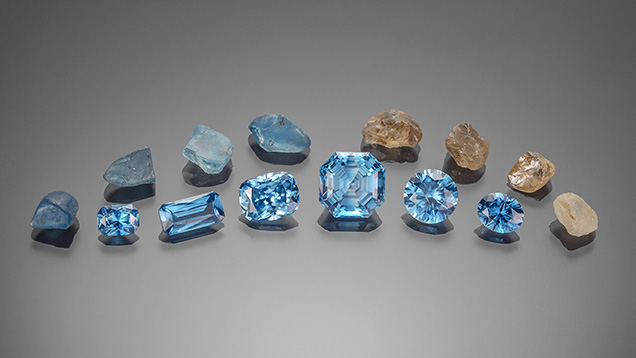Blue Zircon Reportedly from Malawi

Blue zircon is perhaps best known from Cambodia, with most if not all of the material recovered as brown stones that turn blue upon heating. Recently, Brent Smith of Phoenix Gems supplied us with a parcel of rough and cut zircons (see above) reportedly from a new deposit in Malawi. According to Smith, the mine is located in southern Malawi, near Maripa in the district of Chikwawa. The Michigan-based Phoenix Gems is in partnership with Malawi locals Jepther Ngwira and Matthias Chimbuto, who oversee mining. Heat treating and cutting operations are handled by Smith in the United States. Smith also reported that fewer than 10 kg of material has been produced to date, much of which he has heat treated using a proprietary process to produce a range of blue and some bicolor blue and colorless stones. So far, only about 20 stones have been faceted.
Gemological testing revealed properties consistent with blue zircon, including a refractive index that was over the limit of the RI liquid (with a value of 1.81), a hydrostatic SG of 4.52, and a handheld visible spectrum typical for zircon, with the most prominent feature being a sharp absorption line visible at about 654 nm. Exposing the rough blue stones to long-wave ultraviolet light for more than 90 seconds did not induce any UV reaction or obvious change in color, as has been previously reported in blue zircon (N. Renfro, “Reversible color modification of blue zircon by long-wave ultraviolet irradiation,” Fall 2016 G&G, pp. 246–251). Microscopic examination revealed minute needle-like inclusions, partially healed fractures, and prominent blue and colorless zoning, although the stones were relatively free of inclusions. The unpolarized ultraviolet/visible/near-infrared (UV-Vis-NIR) spectrum consisted of a broad absorption band centered at approximately 640 nm, which is the cause of the observed blue color and is seen in the absorption spectrum of blue zircons from other localities. Laser ablation–inductively coupled plasma–mass spectrometry (LA-ICP-MS) chemical analysis confirmed the bulk composition was consistent with zircon, and major trace elements included the rare earth elements yttrium and hafnium as well as transition metals titanium and scandium.
In all, this new source of blue zircon reportedly from Malawi has the potential to yield some beautiful finished stones and is a welcome addition to the gem trade.
.jpg)


